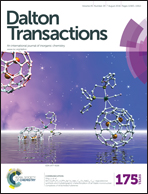Synthesis and structural characterization of anion complexes with azacalix[2]dipyrrolylmethane: effect of anion charge on the conformation of the macrocycle†
Abstract
Tetrahomodiazacalix[2]dipyrrolylmethane 1, [–CH2(C4H3N)CR2(C4H3N)CH2N(Me)–]2 an expanded version of the calix[4]pyrrole system, has the tendency to change its ring conformation (1,3-alternate) upon anion binding analogous to calix[4]pyrrole. However, owing to its tertiary amine nitrogen atoms in the ring, it can be protonated and becomes a powerful cationic receptor for anions, besides its inherent hydrogen bonding features. Macrocycle 1 binds with a series of monoanions BF4−, Cl−, PhCOO− and ClO4−, and their X-ray structures showed that the ring conformation constitutes the 1,2-alternate form. Upon binding with dianions SO42−, CrO42−, SiF62− and S2O32−, the ring conformation changes to the cone conformation. The intermediate partial cone conformation results for complexes with NO3− and Cr2O72− ions. The change in the orientation of the pyrrole NH groups depending on the charge of the anion demonstrates the flexibility of the macrocycle and the dicationic macrocycle stabilizes the anions via both hydrogen bonding and electrostatic interactions.
![Graphical abstract: Synthesis and structural characterization of anion complexes with azacalix[2]dipyrrolylmethane: effect of anion charge on the conformation of the macrocycle](/en/Image/Get?imageInfo.ImageType=GA&imageInfo.ImageIdentifier.ManuscriptID=C6DT01396A&imageInfo.ImageIdentifier.Year=2016)

 Please wait while we load your content...
Please wait while we load your content...